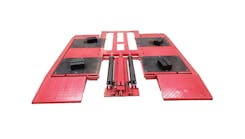11 lift considerations to maximize productivity
Sometimes it is necessary to purchase a 1/2” socket because that specific tool is needed. Yet, most technicians have an adjustable wrench, a multitool, and vise grips. The socket is made for one specific job while the others are made to do many things. Vehicle lifts are no different. Having a lift with the flexibility of a multitool can open up revenue opportunities and increase shop productivity.
No shop wants to turn away or outsource work because they do not have the proper equipment to service the vehicle; saying ‘no’ to a job is sending revenue away. Proper planning when it comes to the shop’s lifts, however, can keep more work in-house. Below are some items to consider when selecting a lift to keep your shop as productive as possible.
Two-post lift considerations
Lift capacity. Many shops have a 10,000-lb capacity two-post lift. It is important to consider, though, that per the Automotive Lift Institute (ALI) and Lifting It Right, a two-post lift should never exceed 1/4 of the rated capacity on any one swing arm. A 10,000-lb capacity is fine if the shop only services light passenger cars, and it may be adequate for a half-ton pickup such as a Silverado 1500 or F-150. However, if the truck is a larger F-350 or F-450 work truck with a welder, service body, or toolboxes, a 10,000-lb capacity two-post lift cannot safely raise that vehicle because the rear arms would be overloaded. A 13,000-lb ambulance can overload a 15,000-lb capacity lift since the rear axle weighs about 8,000 lbs. Were this the case, the lift should be at least a 16,000-lb capacity model.
Lift arms. Two-post lifts require about four to ten minutes per vehicle to properly position each of the four swing arms. Multiply that by five cars per day, five days a week, and positioning arms can add up to 80 hours each year of unproductive repair time (plus the wear on your knees). Some lift brands offer options that allow technicians to avoid positioning the swing arms when they are not necessary for the vehicle being serviced. For example, when servicing the front brakes on a car, the rear arms would not need to be set. Another option allows technicians to convert a two-post frame engaging lift to a drive-on lift which leaves the wheels hanging free. Of course, when all arms are needed, these options can be removed.
Truck adapters. Shops that service vehicles with running boards require truck adapters. Some lift manufacturers include adapters as standard equipment while others charge extra. What is most important is that ALI requires each option for certified lifts to be listed and certified. Research on autolift.org shows there are manufacturers who do not offer certified truck adapters, and using those that are not may void the certification of the lift.
Non-automotive applications. Municipal shops or those that service landscaping equipment are typically responsible for servicing pick-up trucks and passenger cars, in addition to turf maintenance and other smaller equipment. Some lift manufacturers offer two-post lifts with the ability to convert to a turf maintenance equipment lift/golf cart lift and back again. This option gives the shop the flexibility to service cars and trucks, as well as turf equipment.
Weight gauge. Lift safety is an important factor to keep in mind. Per ALI, technicians should always lower the vehicle onto the lift’s locking system before working underneath. Lift manufacturers offer different methods of ensuring the vehicle is resting on the locking system and not relying on the lift’s hydraulics to remain raised. One manufacturer offers a green light that illuminates the ceiling when the vehicle is properly seated, while others offer a weight gauge. When the weight gauge reads 0 lbs, the lift is on the locks.
Foam guards. Every technician, tall or short, has likely hit his or her head on the bottom of a swing arm. The swing arm head guard is an inexpensive option which can be added to the lift in minutes and provides an extra layer of protection for technicians. Similarly, door guards offer protection from damaging vehicle body panels. Opening a vehicle door and hitting the lift’s carriage can cause dents and scratches, necessitating customer apologies. The addition of a Nerf-like foam door guard reduces the customer apologies or ensuing body-shop bills.
Mobile column lift considerations
Mobile column lifts are generally used for heavier vehicles. While some technicians may assume mobile columns strictly engage a tire at each corner, that is not always the case. Mobile column lifts offer available options to help make shops more productive, and allow for the ability to service a wider range of vehicles.
Long fork. Most heavy vehicles have dual tires on the rear, and a good practice is to lift the vehicle using both rear tires, not just the outer tires. Several lift manufacturers offer 22” lifting forks to accommodate this need. Some mobile columns lifts decrease in capacity by 1/3 when using longer lifting forks, however, while others barely decrease in capacity – so it is important to research this ahead of time.
Front-to-rear adapter. Many mobile column manufacturers offer a front-to-rear lift adapter. This adapter allows two mobile columns to do the work of four while leaving all wheels hanging free. Research shows a large discrepancy in capacity reduction when using this option, though. Per Autolift.org, some manufacturers rate this option at 26,000 lbs, while others are shown only rated at 7,500 lbs.
Forklift adapter. Another common option for mobile lifts is a forklift adapter. This adapter allows shops to service forklifts. Again, some lifts are rated at a high enough capacity to raise a 10-12 ton capacity fork-truck, while others can only service 3-ton forklifts.
Drive-on lift considerations
Four post, parallelogram, vertical rise – basically any platform lift – is also known as a drive-on lift.
Rolling jack. The most common option for any drive-on lift is an adequate capacity, wheels-free rolling jack. Without a rolling jack, a drive-on lift basically becomes just an oil change lift. Add a wheels-free jack and the lift is optimized for tire, brake, and front end alignment service. It is important to ensure that when purchasing a truck lift, the manufacturer offers a wheels-free jack in capacities high enough to support the rear end of a work truck, where 60 to 70 percent of the weight is typically held. For example, do not buy a 30,000-lb lift that only offers a 15,000-lb rolling jack, as it would be inadequate to safely lift the rear end.
Lift accessories. LED lighting is a common option for illuminating the undercarriage of a vehicle, and many lift manufacturers offer drive-through ramps (if the facility has a drive through bay). Some even offer air lines routed to the lift to operate pneumatic tools.
As you can see, various lifting accessories and options exist that can help make any model lift more usable, more versatile, or even a bit safer. Review these possibilities with your lift’s manufacturer and keep more service and repair jobs rolling through the door.



